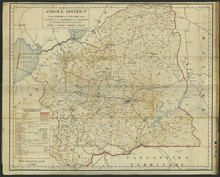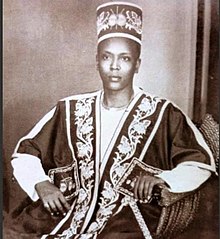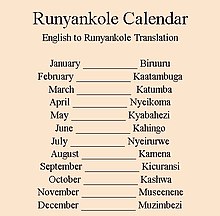Ankole
Kingdom of Ankole Obugabe Bw'Ankole (Nyankole) | |
|---|---|
| 1478–1967 | |
 Flag
 Coat of arms
| |
| Anthem: 'Ensi Nkore, Ensi Nkore' | |
 Location of Ankole (red) in Uganda (pink). | |
| Status | Kingdom |
| Capital | Mbarara[1] |
| Common languages | Runyankole |
| Ethnic groups | Banyankole |
| Government | Constitutional monarchy |
• Omugabe | Prince Charles Rwebishengye |
• | N/A |
| History | |
• Established | 1478 |
• Disestablished | 1967 |
| Area | |
• Total | 16,104 km2 (6,218 sq mi) |
| Population | |
• Estimate | 4.1 Million |
| Currency | Uganda Shillings (UGX) |
| Time zone | UTC+3 (EAT) |
| Calling code | 256 |
Ankole (Runyankore: Nkore), was a traditional Bantu kingdom in Uganda. The kingdom is located in south-western Uganda, east of Lake Edward. It was ruled by a monarch known as the Mugabe or Omugabe. The kingdom was formally abolished in 1967 by the government of President Milton Obote, and since then, the kingdom has not been restored officially.[2] The people of Ankole are called Banyankole (singular: Munyankole) in Runyankole language, a Bantu language.
On 25 October 1901, the Kingdom of Nkore was incorporated into the British Protectorate of Uganda by the signing of the Ankole agreement.[3]
Because of the reorganisation of the country by Idi Amin, Ankole no longer exists as an administrative unit. It is divided into ten districts, namely: Bushenyi District, Buhweju District, Mitooma District, Rubirizi District, Sheema District, Ntungamo District, Mbarara District, Kiruhura District, Ibanda District, and Isingiro District.
Location[]

Ankole Kingdom is located in the South-Western region of Uganda bordering Rwanda and the Democratic Republic of Congo
List of Omugabe of Ankole[]

Names and Dates taken from John Stewart's African States and Rulers (1989).[4]
- Ruhinda (c. 1430 - 1446)
- Nkuba (c. 1446 - 1475)
- Nyaika (c. 1475 - 1503)
- Nyabugaro Ntare I (c. 1503 - 1531)
- Rushango (c. 1531 - 1559)
- Ntare II Kagwejegyerera (c. 1559 - 1587)
- Ntare III Rugamaba (c. 1587 - 1615)
- Kasasira (c. 1615 - 1643)
- Kitera (c. 1643 - 1671) (joint ruler with Kumongye)
- Kumongye (c. 1643 - 1671) (joint ruler with Kitera)
- Mirindi (c. 1671 - 1699)
- Ntare IV Kitabanyoro (c. 1699 - 1727)
- Macwa (c. 1727 - 1755)
- Four joint rulers (c. 1755 - 1783)
- Rwabirere
- Karara I
- Karaiga
- Kahaya I
- Three joint rulers (c. 1783 - 1811)
- Nyakashaija
- Bwarenga
- Rwebishengye
- Kayunga (c. 1811 - 1839) (joint ruler with Gasiyonga I)
- Gasiyonga I (c. 1811 - 1839) (joint ruler with Kayunga)
- Mutambuka (c. 1839 - 1867)
- Ntare V (c. 1867 - 1895)
- Monarchy placed under the Uganda Protectorate in 1896.[4]
- Kahaya II (1895 – 1944)
- Gasiyonga II (1944 – 8 September 1967)
- Monarchy abolished in 1967.[4]
- Ntare VI/John Barigye, 1993–2011 (Titular king)
- Charles Rwebishengye, 2011–present (Titular king/crown prince)
Nkole people[]
Nkole people are a Bantu ethnic group native to Uganda. They primarily inhabit Ankole. They are closely related to other Bantu peoples of the region, namely the Nyoro, Kiga, Toro and Hema peoples. Their population is 4,187,445(9.8% of Uganda). There are several names they are referred to as. These include the following ones: Ankole, Ankori, Banyankole, Banyankore, Nkoles, Nkore, Nyankole, Nyankore, Ouanyankori, Runyankole, Runyankore, Uluyankole, Uluyankore. The Nkole speak Orunyankore, a Great Lakes Bantu language. There were an estimated 2.3 million native speakers in 2002.
Ankole history[]
History of pre-colonial ethnic relations in Ankole[]
The pastoralist Hima (also known as Bahima) established dominion over the agricultural (also known as Bairu) some time before the nineteenth century.[5] The Hima and Iru established close relations based on trade and symbolic recognition, but they were unequal partners in these relations.[5] The Iru were legally and socially inferior to the Hima, and the symbol of this inequality was cattle, which only the Hima could own.[5] The two groups retained their separate identities through rules prohibiting intermarriage and, when such marriages occurred, making them invalid.[5]
The Hima provided cattle products that otherwise would not have been available to Iru farmers.[5] Because the Hima population was much smaller than the Iru population, gifts and tribute demanded by the Hima could be supplied fairly easily.[5] These factors probably made Hima-Iru relations tolerable, but they were nonetheless reinforced by the superior military organization and training of the Hima.[5]
The kingdom of Ankole expanded by annexing territory to the south and east.[5] In many cases, conquered herders were incorporated into the dominant Hima stratum of society, and agricultural populations were adopted as Iru or slaves and treated as legal inferiors.[5] Neither group could own cattle, and slaves could not herd cattle owned by the Hima.[5]
Ankole society evolved into a system of ranked statuses, where even among the cattle-owning elite, patron-client ties were important in maintaining social order. Men gave cattle to the king (mugabe) to demonstrate their loyalty and to mark life-cycle changes or victories in cattle raiding.[5] This loyalty was often tested by the king's demands for cattle or for military service.[5] In return for homage and military service, a man received protection from the king, both from external enemies and from factional disputes with other cattle owners.[5]
The mugabe authorized his most powerful chiefs to recruit and lead armies on his behalf, and these warrior bands were charged with protecting Ankole borders.[5] Only Hima men could serve in the army, however, and the prohibition on Iru military training almost eliminated the threat of Iru rebellion.[5] Iru legal inferiority was also symbolized in the legal prohibition against Iru owning cattle.[5] And, because marriages were legitimized through the exchange of cattle, this prohibition helped reinforce the ban on Hima-Iru intermarriage.[5] The Iru were also denied highlevel political appointments, although they were often appointed to assist local administrators in Iru villages.[5]
The Iru had a number of ways to redress grievances against Hima overlords, despite their legal inferiority.[5] Iru men could petition the king to end unfair treatment by a Hima patron.[5] Iru people could not be subjugated to Hima cattle-owners without entering into a patron-client contract.[5]
A number of social pressures worked to destroy Hima domination of Ankole.[5] Miscegenation took place despite prohibitions on intermarriage, and children of these unions (abambari) often demanded their rights as cattle owners, leading to feuding and cattle-raiding.[5] From what is present-day Rwanda groups launched repeated attacks against the Hima during the nineteenth century.[5] To counteract these pressures, several Hima warlords recruited Iru men into their armies to protect the southern borders of Ankole.[5]
Bairu and Bahima clans[]
Banyankore trace their ancestors back to the Bairu and the Bahima subgroup.[6]
Kingdom abolished[]
The kingdom was abolished in 1967 by the Ugandan government under president Apollo Milton Obote.[6]
Counties of Nkole (Amashaza)[]
Nkore Kingdom was divided into ten counties. These counties are now divided into various political constituencies. But the original ten counties of Nkore include:
- Isingiro
- Ibanda
- Sheema
- Bunyaruguru
- Igara
- Buhweju
Nkole calendar[]

The Nkore calendar was divided into 12 months. They were named according to weather conditions and activities done in that period. They include:
- Biruuru
- Kaatambuga
- Katumba
- Nyeikoma
- Kyabahezi
- Kahingo
- Nyeirurwe
- Kamena
- Kicuransi
- Kashwa
- Museenene
- Muzimbezi
References[]
- ^ Briggs, Philip; Roberts, Andrew (5 November 2016). Uganda. Bradt Travel Guides. p. 534. ISBN 9781784770228. Retrieved 29 December 2016.
- ^ The Observer Media Ltd. :: The Weekly Observer :: Uganda's Top Resource site Archived 3 December 2007 at the Wayback Machine
- ^ The Ankole Agreement 1901
- ^ Jump up to: a b c Stewart, John (1989). African States and Rulers. London: McFarland. p. 201. ISBN 0-89950-390-X.
- ^ Jump up to: a b c d e f g h i j k l m n o p q r s t u v w x y Byrnes, Rita M. (1992). "Banyankole". In Byrnes, Rita M. (ed.). Uganda: a country study (2nd ed.). Washington, D.C.: Federal Research Division, Library of Congress. pp. 59–60. ISBN 0-8444-0749-6. OCLC 25831693.
 This article incorporates text from this source, which is in the public domain.CS1 maint: postscript (link)
This article incorporates text from this source, which is in the public domain.CS1 maint: postscript (link)
- ^ Jump up to: a b "Runyakore History and Culture" (PDF). Runyakore L&C. 26 January 2021.
External links[]
- Ankole
- Ugandan monarchies
- Ethnic groups in Uganda